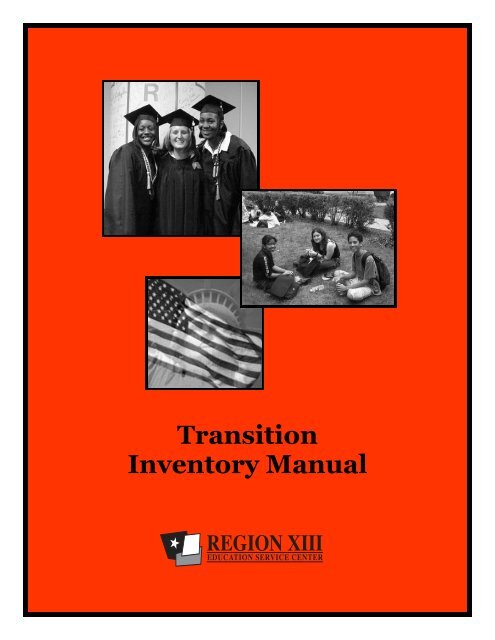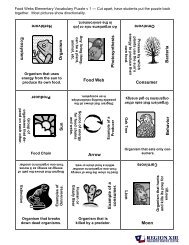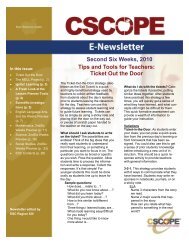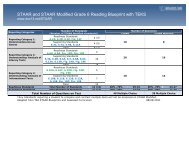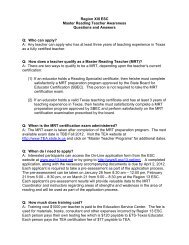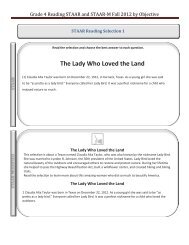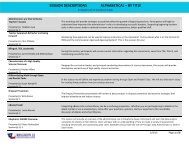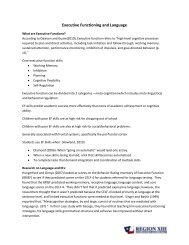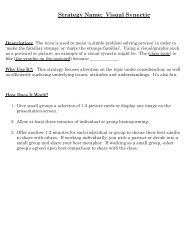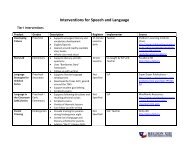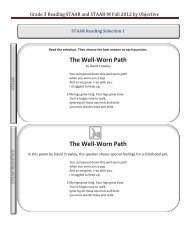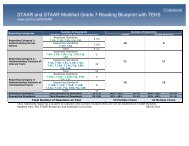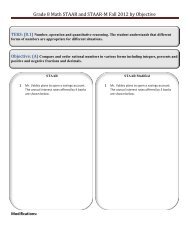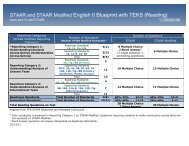Transition Inventory Manual - Region 13
Transition Inventory Manual - Region 13
Transition Inventory Manual - Region 13
You also want an ePaper? Increase the reach of your titles
YUMPU automatically turns print PDFs into web optimized ePapers that Google loves.
<strong>Transition</strong><br />
<strong>Inventory</strong> <strong>Manual</strong>
<strong>Transition</strong><br />
<strong>Inventory</strong> <strong>Manual</strong><br />
Revised 2004<br />
For more information contact:<br />
Candace Bixler<br />
5701 Springdale Road<br />
Austin, Texas 78723<br />
512-919-5494<br />
candace.bixler@esc<strong>13</strong>.txed.net
<strong>Region</strong> XIII Education Service Center<br />
1<br />
Contents<br />
Acknowledgments . . . . . . . . . . . . . . . . . . . . . . . . . . . . . . . . . . . . . . . . . . . . . . . . . . . . . . . . . . . . . 1<br />
Introduction . . . . . .. . . . . . . . . . . . . . . . . . . . . . . . . . . . . . . . . . . . . . . . . . . . . . . . . . . . . . . . . . . . 2<br />
<strong>Transition</strong> Decision-Making Matrix. . . . . . . . . . . . . . . .. . . . . . . . . . . . . . . . . . . . . . . . . . . . . . . . . . 5<br />
Performance Categories<br />
Full Independence . . . . . .. . . . . . . . . . . . . . . . . . . . . . . . . . . . . . . . . . . . . . . . . . . . . . . . . 20<br />
Functional Independence . . . . . . . . . . . . . . . . . . . . . . . . . . . . . . . . . . . . . . . . . . . . . . . . . . 26<br />
Supported Independence . . . . . . . . . . . . . . . . . . . . . . . . . . . . . . . . . . . . . . . . . . . . . . . . . 32<br />
Participation . . . . . . . . . . . . . . . . . . . . . . . . . . . . . . . . . . . . . . . . . . . . . . . . . . . . . . . . . . . 38<br />
Appendix. . . . . .. . . . . .. . . . . . . . . . . . . . . . . . . . . . . . . . . . . . . . . . . . . . . . . . . . . . . . . . . . . . . . 44<br />
Acknowledgments<br />
Thanks to the following people for their collaboration on the <strong>Transition</strong> <strong>Inventory</strong>.<br />
Dana McDonald<br />
Chrissy Cowan<br />
Terrie Bernal-Sanchez Joan Givens<br />
Tom Billings<br />
Elise Hoaglund<br />
Rene Borders Kathy Hutto<br />
Becky Burnett Debra Leff<br />
Diane Christopherson Peggy Stone<br />
Denise Geiger Jenise Ayers<br />
The <strong>Transition</strong> <strong>Inventory</strong> <strong>Manual</strong> is based on standards and performance expectations from Addressing<br />
Unique Educational Needs of Individuals with Disabilities available from the John C. Flanagan<br />
Resource Center, P.O. Box 11<strong>13</strong>, Palo Alto, CA 94302-11<strong>13</strong>.<br />
Not all available resources are included. These materials are works in progress.
<strong>Region</strong> XIII Education Service Center<br />
<strong>Transition</strong> Planning Introduction<br />
Everyone wants the opportunity to succeed in adult life. <strong>Transition</strong> planning is one way to help<br />
provide that opportunity. The goal of transition planning is to ensure that individuals with disabilities<br />
gain the skills and services needed to succeed in life in the “real world.” <strong>Transition</strong> planning actually<br />
begins early in the student’s life. It demands a constant look at student progress throughout the<br />
educational process, birth to adulthood.<br />
2<br />
<strong>Transition</strong> planning is a collaborative effort involving the student, family, educators and the<br />
community. Families, schools and communities equally must be accountable if students are to<br />
succeed.<br />
Why Plan For <strong>Transition</strong>?<br />
<strong>Transition</strong> from school to adult life for any student is a complex process involving many people,<br />
decisions and activities. It is all the more complex for students with disabilities.<br />
Disability Statistics<br />
United States<br />
Numerous studies of youth with disabilities in the areas of employment, living arrangements, and<br />
community participation document a rather discouraging picture of unemployment or long-term<br />
underemployment, minimal opportunities to post-secondary training, an inability to live independently,<br />
few social experiences and restricted participation within their community (Hasazi, Gordon, and Roe,<br />
1985; Wagner, 1991; Sitlington, Frank, and Carson, 1992; Wagner 1993).<br />
Texas<br />
The Texas Education Agency’s Special Education Effectiveness Study (Norris, 1990-1996) found<br />
similar problems in unemployment, underemployment, lack of social relationships, and greater<br />
dependence. The study suggests that a lack of planning, experiences and services at critical points<br />
in the student’s life create barriers to success and a higher quality of life.<br />
IDEA - B<br />
The transition service requirements of the Individuals with<br />
Disabilities Education Act (IDEA) recognizes that education can improve<br />
the traditional post-school outcomes for individuals with disabilities. The<br />
basic purpose of the legislation is to better prepare students with<br />
disabilities to enter the workplace, continue learning, become as<br />
independent as possible and contribute to society. It calls for increased<br />
planning and coordination between school and families to help these youth<br />
meet these challenges. Further, the intent is to enable students to access<br />
supports and services before they leave school. This process promotes<br />
successful movement from school to post-secondary education, training,<br />
employment, independent living and community participation. The focus<br />
is shifted from what the individual cannot do, to what the<br />
individual can do, turning disabilities into capabilities.
<strong>Region</strong> XIII Education Service Center<br />
How is <strong>Transition</strong> Defined?<br />
The Individuals with Disabilities Education Act (IDEA) defines transition services in<br />
Section 300.18 as:<br />
3<br />
A coordinated set of activities for a student, designed within an outcome-oriented process, which<br />
promotes movement from school to post-school activities, including post-secondary education,<br />
vocational training, integrated employment (including supported employment), continuing and<br />
adult education, adult services, independent living, or community preparation. The coordinated set<br />
of activities must (i) be based upon the individual student’s needs; (ii) take into account student<br />
preferences and interests; and (iii) include instruction, community experiences, the development of<br />
employment and other post-school adult living objectives, and, if appropriate, the acquisition of daily<br />
living skills and functional vocational evaluation.<br />
The transition mandate focuses on students’ adult adjustment preparation needs and calls for<br />
transition planning to be a student-driven process with (a) increased parental involvement, (b) an<br />
emphasis on team collaboration and (c) accountability regarding expected outcome student<br />
performances. The transition planning process requires the active participation of the family and<br />
community along with several cooperating agencies and services.<br />
How Can This <strong>Manual</strong> Help You?<br />
The purpose of this manual is three-fold: (1) identify outcomes based on major life roles for all<br />
students; (2) help establish relevant goals and objectives for students in each of four life domains; and<br />
(3) guide accountability. This manual can help districts and families ensure that transition<br />
requirements of the Individuals with Disabilities Education Act (IDEA) are implemented for youth<br />
with disabilities. It provides examples of focus areas, supports, and practices which incorporate the<br />
transition service requirements of IDEA into Individualized Education Plans.<br />
Through the use of the manual’s <strong>Transition</strong> Decision-Making Matrix students, parents,<br />
educators and adult service agency personnel will:<br />
• Establish student preferences and interests<br />
• Focus curriculum and instructional activities to meet transition requirements<br />
• Facilitate coordinated sets of activities between the community, school, home<br />
and service providers<br />
• Monitor efforts to meet requirements<br />
• Write relevant outcome-based goals and objectives regarding transition<br />
• Create a collaborative transition teaming process<br />
• Identify local, state, and national resources<br />
• Assist students with self-determination<br />
• Guide program accountability
<strong>Region</strong> XIII Education Service Center<br />
4<br />
The Components<br />
Below are brief descriptions of the components of the <strong>Transition</strong> Support Process.<br />
Life Domains<br />
The Life Domains are the four basic areas addressed in transition:<br />
• Social/Recreation/Leisure<br />
• Independent Living<br />
• Lifelong Learning<br />
• Employment<br />
Performance Categories<br />
The Performance Category represents the student’s current functional ability (what the student can<br />
do right now) level of independence.<br />
Performance Expectations & Major Life Roles<br />
A Performance Expectation is a desired end point of educational programs for ALL<br />
individuals. These expectations are based on Major Life Roles in which the student should<br />
consistently perform. The Performance Expectations (a) are performance oriented; (b) drive<br />
program elements and assessment systems; (c) reflect empowerment; (d) aid in understanding<br />
criteria for an outcome achievement; and (e) provide orientations that relate to the fulfillment of<br />
an adult living role.<br />
Environments<br />
The structure and atmosphere where performance expectations will be accomplished<br />
are environments. These include school, instructional arrangements, community, and home.<br />
Focus Areas<br />
Explore focus areas for opportunities to provide educational experiences/procedures that<br />
stimulate learning. Activities occur within the environment to assist in achieving the<br />
performance expectation, for example: instructional delivery, learning experiences, home,<br />
school, and community.<br />
Supports<br />
Related sources that assist the student in fulfilling their goals and objectives are supports. Peers,<br />
friends, family, technology, funding, public schools, and adult service providers are examples.<br />
<strong>Transition</strong> Decision-Making Matrix<br />
The matrix is a guide that help identify educational or performance expectations for each category<br />
within the life domains of transition. It is most effective when used as a decision-making tool in<br />
which all participants contribute and build consensus in final decisions regarding student outcome<br />
goals and objectives.
<strong>Region</strong> XIII Education Service Center<br />
5<br />
<strong>Transition</strong> Decision-Making Matrix<br />
The matrix is a collaborative assessment tool that serves as a guide to help identify and prioritize<br />
major life role expectations. It is most effective when used as a decision-making tool in which all<br />
participants contribute their thoughts and feelings and build consensus to assist in making final<br />
decisions regarding student outcome goals and objectives.<br />
The <strong>Transition</strong> Decision-Making Matrix leads to meaningful, collaborative, action based goals and<br />
objectives. Have the student’s team follow the steps to complete the matrix. This process should<br />
take a minimal amount of time.<br />
Instructions for the Primary Teacher Only<br />
The best method of completing this assessment is for the primary teacher to give copies of the<br />
matrix, definitions, and directions of the four Performance Expectation categories to each student’s<br />
team member (i.e., student, teachers, support staff). The hard copy of the matrix (for photocopying)<br />
is found on the next page and the directions are on the following pages. A parent conference may<br />
help facilitate this decision-making process.<br />
Now go to Step 1
<strong>Region</strong> XIII Education Service Center<br />
6<br />
<strong>Transition</strong><br />
Decision-Making Matrix<br />
Life Domains<br />
Social/<br />
Recreation/<br />
Leisure<br />
Adult<br />
Living<br />
Lifelong<br />
Learning<br />
Employment<br />
Full<br />
Independence<br />
select 3 or less PEs<br />
1<br />
2<br />
5<br />
8<br />
9<br />
3<br />
4<br />
5<br />
7<br />
3<br />
4<br />
5<br />
6<br />
7<br />
8<br />
9<br />
2<br />
3<br />
4<br />
5<br />
6<br />
7<br />
8<br />
9<br />
Performance Categories<br />
(Levels of Independence)<br />
Functional<br />
Independence<br />
select 3 or less PEs<br />
Supported<br />
Independence<br />
select 3 or less PEs<br />
4<br />
5<br />
6<br />
7<br />
8<br />
9<br />
10<br />
4<br />
5<br />
6<br />
7<br />
8<br />
2<br />
3<br />
5<br />
6<br />
8<br />
9<br />
10<br />
1<br />
2<br />
4<br />
6<br />
7<br />
8<br />
1<br />
2<br />
6<br />
7<br />
9<br />
10<br />
5<br />
6<br />
8<br />
2<br />
3<br />
4<br />
5<br />
7<br />
9<br />
10<br />
3<br />
4<br />
5<br />
6<br />
8<br />
Participation<br />
select 3 or less PEs<br />
1<br />
3<br />
4<br />
5<br />
3<br />
4<br />
5<br />
2<br />
3<br />
5<br />
2<br />
3<br />
5<br />
*PE = Performance Expectation<br />
Based on Addressing Unique Educational Needs of Individuals with Disabilities<br />
Collaborative Assessment Tool<br />
Form TD-MM 1.1
<strong>Region</strong> XIII Education Service Center<br />
7<br />
Step 1<br />
Locate the four Performance Categories on the matrix (Full Independence, Functional<br />
Independence, Supported Independence, Participation).<br />
Life Domains<br />
Social/<br />
Recreation/<br />
Leisure<br />
Adult<br />
Living<br />
Lifelong<br />
Learning<br />
Employment<br />
Full<br />
Independence<br />
select 3 or less PEs<br />
Performance Categories<br />
(Levels of Independence)<br />
Functional<br />
Independence<br />
select 3 or less PEs<br />
Supported<br />
Independence<br />
select 3 or less PEs<br />
Participation<br />
select 3 or less PEs<br />
*PE = Performance Expectation<br />
Based on Addressing Unique Educational Needs of Individuals with Disabilities<br />
Collaborative Assessment Tool
Step 2<br />
<strong>Region</strong> XIII Education Service Center<br />
!Locate the four Life Domains across the top of the matrix (Social/Recreation/Leisure,<br />
Adult Living, Lifelong Learning, Employment). Select appropriate Life Domains to be<br />
addressed by the student this current school year. NOTE: Addressing the Life Domain areas<br />
of Social/Recreation/Leisure, Adult Living, Lifelong Learning, and Employment are required<br />
by IDEA-B.<br />
8<br />
Life Domains<br />
Social/<br />
Recreation/<br />
Leisure<br />
Adult<br />
Living<br />
Lifelong<br />
Learning<br />
Employment<br />
Full<br />
Independence<br />
select 3 or less PEs<br />
Performance Categories<br />
(Levels of Independence)<br />
Functional<br />
Independence<br />
select 3 or less PEs<br />
Supported<br />
Independence<br />
select 3 or less PEs<br />
Participation<br />
select 3 or less PEs<br />
*PE = Performance Expectation<br />
Based on Addressing Unique Educational Needs of Individuals with Disabilities<br />
Collaborative Assessment Tool
Step 3<br />
<strong>Region</strong> XIII Education Service Center<br />
!Read the definitions of the Performance Categories.<br />
(Full Independence, Functional Independence, Supported Independence,<br />
Participation)<br />
!Identify which category or categories (level of independence) apply based on the<br />
student’s current performance and cognitive ability.<br />
!Think in terms of the individual’s functioning ability today.<br />
Performance Category Definitions<br />
Full Independence<br />
An individual with full independence may have<br />
physical, emotional, or learning disabilities, but<br />
functions in the normal range of intelligence.<br />
She can apply knowledge to tasks, problems, or<br />
activities she encounters. Her cognitive ability<br />
allows her to transfer or generalize learning across<br />
all performance contexts, or the life domains of<br />
social/recreation/leisure, independent living,<br />
lifelong learning, and employment. She is aware of<br />
cognitive processes, personal work characteristics,<br />
and interpersonal effectiveness. The fully independent<br />
person has developed a comprehensive set of<br />
skills, competencies, and orientations to complete<br />
tasks and activities encountered within the major<br />
performance contexts of adult life.<br />
Functional Independence<br />
An individual with functional independence<br />
may have mild impairment, or function as if<br />
he had such an impairment. He has some<br />
cognitive limitations that impact his ability to<br />
transfer or generalize learning across the performance<br />
contexts. He should be able to assess<br />
personal strengths and limitations, and to access<br />
resources and supports. He is capable of meeting<br />
his needs and living successfully in the community<br />
without overt support from others. He has learned<br />
a set of skills, competencies and interests that are<br />
required for independent living. Students expected<br />
to achieve functional independence may require<br />
content and instructional strategies focusing on<br />
independent living skills. Instruction must be<br />
concrete and relevant to each setting in which the<br />
student is expected to function because ability to<br />
generalize is limited. A balance of teaching<br />
functional academic skills and functional daily<br />
living skills is necessary for this student.<br />
Supported Independence<br />
The individual with supported independence has a<br />
moderate mental impairment and is expected to<br />
require ongoing support throughout adulthood. She<br />
has cognitive limitations that seriously impact her<br />
ability to generalize or transfer learning. Because she<br />
will require some supervision and support throughout<br />
her life, she must develop skills, competencies<br />
and interests required for living in a supervised<br />
setting. She is capable of completing familiar and<br />
basic activities of daily living, but requires support or<br />
assistance to establish and maintain desired behaviors.<br />
She can perform previously learned routines<br />
and demonstrates some level of independent living<br />
skill. Performance Expectations focus on task<br />
completion and activities of daily living, enhancing<br />
quality of life, and maximizing personal effectiveness.<br />
They reflect the intent for this individual to live a<br />
productive and fulfilling life with as much independence<br />
and personal decision making as possible.<br />
Participation<br />
An individual functioning within the participation<br />
category of performance expectations has severe or<br />
profound mental impairment. He is expected to<br />
require extensive ongoing support throughout<br />
adulthood. Cognitive deficit is significant, perhaps in<br />
combination with severe physical or sensory deficits.<br />
His need for continuous support necessitates educational<br />
targets of participation in life roles rather than<br />
independence. Preparation should strive for a maximum<br />
level of participation, not a level of skill. He<br />
should be informed of options and given opportunities<br />
to participate in personal decisions (what to<br />
wear, etc.). This individual is not able to generalize or<br />
transfer learning. He may perform a few daily living<br />
skills. His ability to perform activity-related tasks<br />
with any consistency is not reliable. His dependence<br />
on others for most, if not all, daily needs makes<br />
necessary an extensive ongoing support system.<br />
Integration of this individual as fully as possible into<br />
major life roles will require cooperative effort by<br />
home, school and communtiy.<br />
9
<strong>Region</strong> XIII Education Service Center<br />
10<br />
Step 4<br />
! Using the matrix match each Life Domain to the Performance Category which<br />
represents the student’s current functional ability (what the student can do right now).<br />
Refer to the definitions in Step 1 if necessary.<br />
# Highlight the matched boxes with a<br />
highlighter. Focus on the highlighted boxes only.<br />
Life Domains<br />
Social/<br />
Recreation/<br />
Leisure<br />
Adult<br />
Living<br />
Lifelong<br />
Learning<br />
Employment<br />
Full<br />
Independence<br />
select 3 or less PEs<br />
Performance Categories<br />
(Levels of Independence)<br />
Functional<br />
Independence<br />
select 3 or less PEs<br />
Supported<br />
Independence<br />
select 3 or less PEs<br />
Participation<br />
select 3 or less PEs<br />
*PE = Performance Expectation<br />
Based on Addressing Unique Educational Needs of Individuals with Disabilities<br />
Collaborative Assessment Tool
Step 5<br />
<strong>Region</strong> XIII Education Service Center<br />
11<br />
! Read the Performance Expectations listed in each<br />
Performance Category below.<br />
# Note that there are Performance Expectations(PE) numbers on the <strong>Transition</strong><br />
Decision- Making Matrix.<br />
$ Review the Performance Expectations for each Life Domain.<br />
Full Independence<br />
Performance Expectations-(PE)<br />
This list of Performance Expectations corresponds to the PE Numbers on<br />
the <strong>Transition</strong> Decision-Making Matrix.<br />
1. Interact effectively in social situations and settings.<br />
2. Contribute to the attainment of group goals.<br />
3. Complete assigned or routine tasks and fulfill responsibilities.<br />
4. Manage personal, career, and other life decisions.<br />
5. Express themselves effectively through oral and other nonwritten means.<br />
6. Express themselves effectively through print means.<br />
7. Complete complex cognitive tasks effectively.<br />
8. Manage unstructured time.<br />
9. Move about/travel effectively within and beyond their community.<br />
Functional Independence<br />
Performance Expectations-(PE)<br />
This list of Performance Expectations corresponds to the PE Numbers on<br />
the <strong>Transition</strong> Decision-Making Matrix.<br />
1. Express themselves effectively in print.<br />
2. Complete tasks relying on the interpretation and use of oral, print, or numeric information.<br />
3. Interact appropriately within the course of daily social, vocational, and community living.<br />
4. Manage personal, career, and other life decisions.<br />
5. Respond effectively to potentially harmful situations involving themselves and others.<br />
6. Access and use community resources and their services as needed to meet daily living needs<br />
and fulfill desires.<br />
7. Travel safely within and beyond their community.<br />
8. Complete routine personal care and health and fitness activities.<br />
9. Manage immediate and long-term responsibilities associated with task completion.<br />
10. Manage unstructured time.
<strong>Region</strong> XIII Education Service Center<br />
12<br />
Supported Independence<br />
Performance Expectations-(PE)<br />
This list of Performance Expectations corresponds to the PE Numbers<br />
on the <strong>Transition</strong> Decision-Making Matrix.<br />
1. Complete personal care and health and fitness activities.<br />
2. Complete domestic activities in personal living environments.<br />
3. Manage personal work assigments.<br />
4. Complete activities requiring transactions in the community.<br />
5. Participate effectively in group situations.<br />
6. Respond effectively to unexpected events and potentially harmful situations.<br />
7. Manage unstructured time.<br />
8. Proceed appropriately toward the fulfillment of personal desires.<br />
Participation<br />
Performance Expectations-(PE)<br />
This list of Performance Expectations corresponds to the PE Numbers<br />
on the <strong>Transition</strong> Decision-Making Matrix.<br />
1. Engage in typical patterns of leisure activities in the home and community.<br />
2. Engage in typical patterns of interactions.<br />
3. Engage in effective communication cycles.<br />
4. Participate in personal care, health, and safety routines.<br />
5. Reach desired locations safely within familiar environment.
<strong>Region</strong> XIII Education Service Center<br />
<strong>13</strong><br />
Step 6<br />
! Locate the first Life Domain of Social/Recreation/Leisure. Follow it down to the area<br />
box that you highlighted (level of independence).<br />
" Look at that Performance Categories (level of independence) and the list of Performance<br />
Expectations listed on the previous two pages. Performance Expectations are listed by<br />
number in the boxes.<br />
# For each highlighted box read the Performance Expectation and circle the PE number<br />
(Figure 4) that will lead the student to minimal support in that Performance Category<br />
(circle no more than three Performance Expectations based on the student’s most<br />
immediate needs (i.e., safety issues, age appropriateness, meaningful to the student).<br />
$ Repeat this process for each Life Domain.<br />
Note: Students may have different Performance Expectations under each Life Doman selected.<br />
Figure 4
<strong>Region</strong> XIII Education Service Center<br />
14<br />
Step 7<br />
• The student’s primary teacher collects the matrices and reviews the results.<br />
• Combine the collection of matrices into one matrix picture resulting in a collaboration<br />
of highlighted boxes signifying the team’s perception of current functioning (level of<br />
independence) according to the Performance Categories (Figure 5).<br />
• If the results are not clear (e.g., student seems to be functioning within two categories or<br />
various matrices differ) start with the most independent category (See *NOTE below).<br />
If the results from the student team indicate a large discrepancy in regards to<br />
Performance Categories (level of independence), a meeting is indicated for further<br />
discussion.<br />
Figure 5<br />
*Note:<br />
If the consensus of the team determines the student is functioning between<br />
Performance Categories (levels of independence), think in terms of<br />
maximum to minimal support and set goals towards minimal support within<br />
the Performance Categories (levels of independence).
Step 8<br />
<strong>Region</strong> XIII Education Service Center<br />
• Turn to the tabbed section in this manual that corresponds to the Performance Category<br />
selected for the student (e.g., Full, Functional, Supported Independence or Participation).<br />
• Locate the selected Life Domains.<br />
• Determine which Environments (Home, Community, School) will be addressed this<br />
current school year based on the student’s most immediate needs (e.g., safety, age<br />
appropriateness).<br />
• The Performance Expectations and Focus Areas form the basis in developing goals and<br />
objectives for the student for the current school year.<br />
• Use the possible Focus Areas that are provided for each Environment to help the student select<br />
his goals and objectives according to the prioritized Performance Expectations (see Matrix)<br />
under each selected Life Domain.<br />
• Teacher Tool - For a quick, complete explanation and application of the matrix refer to<br />
“Shortcut To Teaching The <strong>Transition</strong> Decision-Making Matrix” pages 44-45.<br />
Figure 6 is an example of a completed <strong>Transition</strong> Decision-Making Matrix.<br />
15<br />
Figure 6
Step 9<br />
<strong>Region</strong> XIII Education Service Center<br />
A goal and objective can easily be written by combining the students’:<br />
(1) Performance Category with the (2) Life Domain = GOAL<br />
(3) Performance Expectation (4) Environment (5) Focus Area Activity (6) Supports (7) Criteria<br />
(measure of achievement) = OBJECTIVE (Figure 7).<br />
Figure 7 Flow Chart Of The <strong>Transition</strong> Decision-Making Matrix Process<br />
16<br />
♦ Full Independence<br />
♦ Functional Independence<br />
♦ Supported Independence<br />
♦ Participation<br />
♦ Social /Recreation/Leisure<br />
♦ Adult Living<br />
♦ Lifelong Learning<br />
♦ Employment<br />
TPI<br />
Shortcut<br />
♦ Under each PC<br />
♦ T he list of PE corresponds to the PE num bers<br />
on the <strong>Transition</strong> D ecision-M aking M atrix<br />
♦ Home<br />
♦ Community<br />
♦ School<br />
♦ Listed under Environments<br />
(i.e. Friendships, Local Government, Transportation,<br />
Adult Service Providers, Educational Services, etc.)<br />
♦ Additions can be m ade to lists<br />
(lists arw not all inclusive)<br />
♦ With support from…<br />
(club, friend, band, community member, etc.)<br />
♦ e.g. 3 out of 4 trials, % accuracy,<br />
or # completed
<strong>Region</strong> XIII Education Service Center<br />
17<br />
Using The <strong>Transition</strong> <strong>Inventory</strong> To Write<br />
Measureable Goals And Objectives<br />
EXAMPLE:<br />
GOAL:<br />
The student will achieve 1 Supported Independence in<br />
2 Social/Recreation/Leisure<br />
OBJECTIVE:<br />
Joe will 3 manage unstructured time 4 at school<br />
by 5 participating in activities with 6 the band<br />
7 7out of 10 opportunities.<br />
NOTES:<br />
* Goals are annual achievable action steps.<br />
* Objectives are the measureable, achievable action plan steps to get to a goal.<br />
* Lesson Plans are daily activities in the focus areas designed to achieve individual<br />
student objectives.<br />
* The teacher’s professional judgement and required TEKS determine what lessons or<br />
activities (steps to achieve objectives) are taught.
<strong>Region</strong> XIII Education Service Center<br />
18<br />
Guide To Goal and Objective Writing<br />
<strong>Transition</strong> <strong>Inventory</strong> <strong>Manual</strong><br />
Name: __________________________________<br />
Student will (achieve, demonstrate, increase, etc.)<br />
Date: ______________________<br />
1. Performance Category: (Current functioning level of independence)<br />
__________________________________________________________________________________________<br />
__________________________________________________________________________________________<br />
___________________________________________________________________________________________<br />
2. Life Domain(s): (Areas of life needs)<br />
_____________________________________________________________________________________________<br />
___________________________________________________________________________________________<br />
____________________________________________________________________________________________<br />
Goal: (Combination of one and two above)<br />
___________________________________________________________________________________________<br />
____________________________________________________________________________________________<br />
____________________________________________________________________________________________<br />
3. Performance Expectation(s): (What is the expectation of the student )<br />
____________________________________________________________________________________________<br />
____________________________________________________________________________________________<br />
____________________________________________________________________________________________<br />
4. Environment(s): (Where it will take place)<br />
___________________________________________________________________________________________<br />
____________________________________________________________________________________________<br />
____________________________________________________________________________________________<br />
5. Focus Area: (Idea Generator)<br />
____________________________________________________________________________________________<br />
___________________________________________________________________________________________<br />
____________________________________________________________________________________________<br />
6. Support(s): (Who or what will support the student)<br />
____________________________________________________________________________________________<br />
____________________________________________________________________________________________<br />
____________________________________________________________________________________________<br />
7. Criteria: (Measure of achievement)<br />
____________________________________________________________________________________________<br />
___________________________________________________________________________________________<br />
____________________________________________________________________________________________<br />
Objective: (Combination of three - seven above)<br />
____________________________________________________________________________________________<br />
___________________________________________________________________________________________<br />
____________________________________________________________________________________________<br />
_________________________________________________________________________________
<strong>Region</strong> XIII Education Service Center<br />
19<br />
Step 10<br />
Use The<br />
<strong>Transition</strong> Resource <strong>Manual</strong><br />
“Moving from Philosophy to Practice”<br />
For Resources And Activities<br />
NOTES
<strong>Region</strong> XIII Education Service Center<br />
20<br />
Full Independence<br />
What is Full Independence?<br />
An individual with full independence may have physical, emotional, or learning disabilities,<br />
but functions in the normal range of intelligence. The individual can apply<br />
knowledge to tasks, problems, or activities she encounters. *Their cognitive ability<br />
allows them to transfer or generalize learning across all performance contexts, or the<br />
life domains of social/recreation/leisure, independent living, lifelong learning, and<br />
employment. She has awareness of cognitive processes, personal work characteristics,<br />
and interpersonal effectiveness. The fully independent person has developed a comprehensive<br />
set of skills, competencies, and orientations to complete tasks and activities<br />
encountered within the major performance contexts of adult life.<br />
* Cognitive ability is the only separating factor between the categories<br />
Performance Expectations<br />
This list of Performance Expectations corresponds to the PE Numbers of the<br />
<strong>Transition</strong> Decision-Making Matrix.<br />
1. Interact effectively in social situations and settings.<br />
2. Contribute to the attainment of group goals.<br />
3. Complete assigned or routine tasks and fulfill responsibilities.<br />
4. Manage personal, career, and other life decisions.<br />
5. Express themselves effectively through oral and other nonwritten means.<br />
6. Express themselves effectively through print means.<br />
7. Complete complex cognitive tasks effectively.<br />
8. Manage unstructured time.<br />
9. Move about/travel effectively within and beyond their community.<br />
For Full Independence In:<br />
Social/Recreation/Leisure<br />
Go to page 21<br />
Adult Living<br />
Go to page 22<br />
Lifelong Learning<br />
Go to page 23<br />
Employment<br />
Go to page 24
<strong>Region</strong> XIII Education Service Center<br />
21<br />
Full Independence: Social/Recreation/Leisure<br />
Environment:<br />
Home<br />
Environment:<br />
Community<br />
Environment:<br />
School<br />
Focus Area:<br />
Friendships<br />
interacting with peers, neighbors<br />
and relatives<br />
computer (e.g., Internet chat rooms)<br />
Domestic Resources<br />
games<br />
music<br />
computer<br />
television<br />
hobbies<br />
family outings (e.g., eating out)<br />
access to media (e.g., newspaper,<br />
magazines, books)<br />
Focus Area:<br />
Local Government<br />
library activities<br />
informal classes (e.g., dancing, cooking,<br />
arts/crafts)<br />
Local Resources<br />
media (e.g., calendar of events, radio,<br />
TV, Internet, movies)<br />
clubs<br />
informal classes (e.g., dancing, cooking,<br />
arts/crafts)<br />
performing arts<br />
church activities<br />
water recreation<br />
equestrian activities (e.g., rodeo clubs)<br />
Focus Area:<br />
Least Restrictive<br />
Environment<br />
classroom options - general education<br />
classes<br />
extracurricular options (e.g., sports,<br />
clubs, peer mediation, scouts,<br />
student government)<br />
School-Sponsored Activities<br />
dances<br />
pep rallies<br />
fund raisers<br />
holiday celebrations<br />
concerts/plays<br />
Transportation<br />
community access<br />
travel agencies<br />
Sports Activities<br />
spectator sports<br />
participant
<strong>Region</strong> XIII Education Service Center<br />
22<br />
Full Independence: Adult Living<br />
Environment:<br />
Home<br />
Environment:<br />
Community<br />
Environment:<br />
School<br />
Focus Area:<br />
Domestic Responsibilities<br />
cleaning<br />
cooking<br />
laundry<br />
yard work<br />
personal care (e.g., hygiene,<br />
grooming, health)<br />
Transportation<br />
auto modification<br />
automotive maintenance<br />
driver’s education<br />
Access Service Providers<br />
barrier free environment<br />
modifications for activities of daily<br />
living<br />
Informational Resources<br />
housing (e.g., apartments,<br />
roommates, dorms)<br />
household management<br />
(e.g., cooking, home repair)<br />
media<br />
Financial Responsibilities<br />
allowances<br />
budgeting (e.g., banking, bills,<br />
credit)<br />
student financial aid<br />
Focus Area:<br />
Transportation<br />
public transportation option (e.g., ride<br />
share, bus taxi)<br />
Resources for Living Options<br />
newspaper advertisements<br />
roommate finders<br />
apartment guides<br />
real estate agencies<br />
Adult Service Providers<br />
architecture barrier removal program<br />
modifications to home<br />
advocacy<br />
legal assistance<br />
Community Organizations<br />
neighborhood watch groups<br />
civic responsibility groups<br />
neighborhood block gatherings<br />
churches<br />
Local Government<br />
fire department<br />
police department<br />
voter participation<br />
hostpitals/minor emergency/emergency<br />
medical services<br />
phone directory (blue pages for<br />
community services)<br />
Private Services<br />
house cleaning<br />
meal preparation<br />
health care needs<br />
Focus Area:<br />
Educational Services<br />
curriculum (e.g., home/family,<br />
management, health,<br />
personal finance)<br />
Counseling<br />
community linkages<br />
guidance with decision making<br />
student financial aid<br />
Transportation<br />
driver’s education
<strong>Region</strong> XIII Education Service Center<br />
23<br />
Full Independence: Lifelong Learning<br />
Environment:<br />
Home<br />
Environment:<br />
Community<br />
Environment:<br />
School<br />
Focus Area:<br />
Access to Choices<br />
finances/purchases<br />
time management<br />
Person Centered Planning<br />
insurance, wills<br />
advocacy<br />
self-determination<br />
ordering/subscribing (e.g., magazines,<br />
pizza, catalogs)<br />
Domestic Chores<br />
house cleaning<br />
cooking<br />
laundry<br />
yard maintenance<br />
shopping<br />
Financial Responsibility<br />
budget<br />
investments<br />
credit/debit cards<br />
checking/savings account<br />
scams<br />
Citizenship<br />
voter registration<br />
jury duty<br />
political process/issues<br />
Information on Continuing<br />
Education<br />
2- or 4-year programs(Universities/<br />
colleges)<br />
distance learning (e.g., TV, computer<br />
course through Internet)<br />
library<br />
Internet access<br />
Transportation<br />
driver’s license<br />
taxi<br />
public transportation<br />
bicycles<br />
Focus Area:<br />
Career Pathways/<br />
School-to-Work<br />
internships<br />
apprenticeship<br />
Community Activities<br />
newspaper<br />
radio<br />
television<br />
Internet<br />
Local Government<br />
city libraries<br />
education lectures<br />
voting activities<br />
Community Colleges/<br />
Universities/Technical<br />
Schools<br />
degree programs<br />
Focus Area:<br />
Educational Services<br />
4-year high school graduation plan<br />
gifted/talented programs<br />
dual credit programs<br />
correspondence/distance learning<br />
2- or 4-year institutions of higher<br />
learning<br />
informal classes<br />
continuing education classes<br />
extracurricular activities<br />
student financial aid<br />
Guidance Counseling<br />
career/college days<br />
provide information on options for<br />
educational classes<br />
provide information on funding,<br />
college entrance exams<br />
Computer Access<br />
Internet<br />
distance learning<br />
computer literacy
<strong>Region</strong> XIII Education Service Center<br />
24<br />
Full Independence: Employment<br />
Environment:<br />
Home<br />
Environment<br />
Community<br />
Environment:<br />
School<br />
Focus Area:<br />
Informational Resources<br />
family/relatives<br />
friends<br />
access to media<br />
(e.g., Internet, newspaper, TV,<br />
bulletin boards)<br />
magazines/books<br />
Job Skills<br />
skill mentoring (e.g., woodworking,<br />
mechanic, cooking)<br />
chores<br />
organization<br />
neighborhood jobs<br />
Social Skills<br />
collaboration<br />
manners<br />
conflict resolution<br />
self-advocacy<br />
harassment<br />
Transportation<br />
driver’s education<br />
public transportation<br />
Focus Area:<br />
Community/School<br />
Partnerships<br />
internships<br />
apprenticeships<br />
job shadowing<br />
volunteer<br />
career investigation<br />
career fairs<br />
career pathways<br />
mentors (e.g., rotary clubs, Lion’s clubs)<br />
Informational Resources<br />
newspaper<br />
television<br />
radio<br />
bulletin boards<br />
current employment trends<br />
job banks<br />
Internet<br />
informal classes (e.g., business<br />
ownership, resume)<br />
human resource departments<br />
chamber of commerce<br />
Employment Services<br />
Texas Workforce Commission (e.g., job<br />
locators, resume)<br />
temporary employment services<br />
employment agencies<br />
Transportation<br />
driver’s education<br />
public transportation<br />
ride share<br />
Focus Area:<br />
Educational Services<br />
4-year high school graduation plan<br />
vocational education courses<br />
counseling and guidance<br />
transportation<br />
aptitude/interest inventory<br />
driver’s education<br />
Technical Preparation/<br />
School-to-Work Activities<br />
career pathways<br />
career exploration<br />
job shadowing<br />
assessment<br />
internship<br />
apprenticeships<br />
community services<br />
ROTC<br />
volunteer
<strong>Region</strong> XIII Education Service Center<br />
25<br />
Notes
Functional Independence<br />
<strong>Region</strong> XIII Education Service Center<br />
26<br />
What is Functional Independence?<br />
An individual with functional independence may have mild impairment, or functions as if he had<br />
such an impairment. He has some *cognitive limitations that impact his ability to transfer or generalize<br />
learning across the performance contexts. He should be able to assess personal strengths and limitations,<br />
and to access resources and supports. He is capable of meeting his own needs and living successfully in<br />
the community without overt support from others. He has learned a set of skills, competencies and<br />
interests that are required for independent living.<br />
Students expected to achieve functional independence may require content and instructional strategies<br />
focusing on independent living skills. Instruction must be concrete and relevant to each setting in which<br />
the student is expected to function because ability to generalize is limited. A balance of teaching<br />
functional academic skills and functional daily living skills is necessary for this student.<br />
*Cognitive ability is the only separating factor between the categories<br />
Performance Expectations<br />
This list of Performance Expectations corresponds to the PE Numbers on the<br />
<strong>Transition</strong> Decision-Making Matrix.<br />
1. Express themselves effectively in print.<br />
2. Complete tasks relying on the interpretation and use of oral, print, or numeric information.<br />
3. Interact appropriately within the course of daily social, vocational, and community living.<br />
4. Manage personal, career, and other life decisions.<br />
5. Respond effectively to potentially harmful situations involving themselves and others.<br />
6. Access and use community resources and their services as needed to meet daily living needs and<br />
fulfill desires.<br />
7. Travel safely within and beyond their community.<br />
8. Complete routine personal care and health and fitness activities.<br />
9. Manage immediate and long-term responsibilities associated with task completion.<br />
10. Manage unstructured time.<br />
For Functional Independence In:<br />
Social/Recreation/Leisure<br />
Go to page 27<br />
Adult Living<br />
Go to page 28<br />
Lifelong Learning<br />
Go to page 29<br />
Employment<br />
Go to page 30
<strong>Region</strong> XIII Education Service Center<br />
27<br />
Functional Independence: Social/Recreation/Leisure<br />
Environment:<br />
Home<br />
Environment:<br />
Community<br />
Environment:<br />
School<br />
Focus Area:<br />
Friendships<br />
mentors<br />
computer (e.g., Internet chat rooms)<br />
interactions with peers, neighbors and<br />
relatives<br />
Domestic Resources<br />
games<br />
music<br />
computer<br />
television<br />
hobbies<br />
family outing (e.g., eating out)<br />
access to media (e.g., books/<br />
magazines on tape, newspaper)<br />
Focus Area:<br />
Local Government<br />
parks and recreation<br />
library activities<br />
Local Resources<br />
equestrian activities (e.g., rodeo clubs)<br />
performing arts<br />
informal classes (e.g., dancing, cooking,<br />
arts/crafts)<br />
water recreation<br />
church activities<br />
media (e.g., calendars of events, TV,<br />
Internet, movies)<br />
clubs<br />
Transportation<br />
community access (e.g., bus, rural<br />
transit, taxis)<br />
travel agencies<br />
Sports Activities<br />
spectator sports<br />
participant<br />
Focus Area:<br />
Least Restrictive Environment<br />
classroom options-general education<br />
classes (individualized modifications)<br />
extracurricular options (e.g., sports,<br />
clubs, peer mediation, scouts)<br />
School-Sponsored Activities<br />
dances<br />
pep rallies<br />
fund raisers<br />
holiday celebrations<br />
concerts/plays<br />
School-to-Home Communications<br />
(e.g., all school sponsored activities/<br />
resources)<br />
Mentorships<br />
Big Brother/Sister program<br />
adult community mentor<br />
PALS
<strong>Region</strong> XIII Education Service Center<br />
28<br />
Functional Independence: Adult Living<br />
Environment:<br />
Home<br />
Environment:<br />
Community<br />
Environment:<br />
School<br />
Focus Area:<br />
Domestic Responsibilities<br />
cooking<br />
cleaning<br />
laundry<br />
yard work<br />
personal care (e.g., grooming,<br />
hygiene, health)<br />
Transportation<br />
auto modification<br />
public transportation training<br />
automotive maintenance<br />
Access Service Providers<br />
housing<br />
financial planning/budgeting<br />
barrier-free environment<br />
modification for activities of daily<br />
living<br />
Informational Resources<br />
housing (e.g., apartments,<br />
roommates)<br />
household management (e.g.,<br />
cooking, home repair)<br />
safety (home and community)<br />
media<br />
scams<br />
social norms (e.g., neighbor<br />
relationships)<br />
Financial Responsibilities<br />
student financial aid<br />
allowances<br />
budgeting (e.g., banking, credit, bills)<br />
organization/timelines<br />
Focus Area:<br />
Transportation<br />
public transportation options (e.g., ride<br />
share, bus, taxi)<br />
Resources for Living Options<br />
newspaper advertisements<br />
apartment guides<br />
real estate agencies<br />
roommate finders<br />
Adult Service Providers<br />
architecture barrier removal program<br />
advocacy<br />
legal assistance<br />
modifications to home<br />
Community Organizations<br />
neighborhood watch groups<br />
civic responsibility groups<br />
neighborhood block gatherings<br />
churches<br />
Local Government<br />
police department<br />
fire department<br />
hospitals/minor emergency/emergency<br />
medical services<br />
voter participation<br />
Private Services<br />
house cleaning<br />
meal preparation<br />
health care needs<br />
Focus Area:<br />
Educational Services:<br />
curriculum (e.g., home, family<br />
management, health, personal<br />
finance)<br />
transition process<br />
Counseling (General and<br />
Special Education)<br />
community linkages<br />
information on living options<br />
guidance with decision making<br />
student financial aid<br />
Transportation<br />
community transit system training<br />
driver’s education
<strong>Region</strong> XIII Education Service Center<br />
Functional Independence: Lifelong Learning<br />
29<br />
Environment:<br />
Home<br />
Environment:<br />
Community<br />
Environment:<br />
School<br />
Focus Area:<br />
Access to Choices<br />
finances/purchases<br />
time management<br />
Person Centered Planning<br />
self advocacy<br />
setting personal goals<br />
ordering/subscribing (e.g., magazines,<br />
pizza, catalogs)<br />
Domestic Chores<br />
house cleaning<br />
cooking<br />
shopping<br />
laundry<br />
Financial Responsibility<br />
budget<br />
checking/savings accounts<br />
credit/debit cards<br />
how to not get taken:<br />
phone<br />
Internet scams<br />
mail<br />
Citizenship<br />
voter registration<br />
jury duty<br />
political process/issues<br />
Information on Continuing<br />
Education<br />
community colleges<br />
trade schools<br />
internships<br />
informal classes<br />
distance learning (e.g., TV, computer<br />
course through Internet)<br />
Transportation<br />
driver’s license<br />
public transportation<br />
taxis<br />
ride share program<br />
Focus Area:<br />
Community Colleges/<br />
Universities/Technical Schools<br />
informal classes<br />
degree programs<br />
continuing education courses<br />
adult literacy programs<br />
trade schools<br />
distance learning<br />
Local Government<br />
city libraries<br />
educational lectures<br />
voting activities<br />
Community Organizations<br />
religious organizations<br />
special interests (e.g., collectors groups)<br />
Career Pathways/School-to-Work<br />
Activities<br />
internships<br />
apprenticeships<br />
Community Acitivity<br />
Resources<br />
newspaper<br />
radio<br />
television/radio<br />
Internet<br />
Focus Area:<br />
Educational Services<br />
4-year high school graduation plans<br />
tech prep courses<br />
career pathways/school-to-work<br />
informal classes<br />
continuing education classes<br />
content mastery<br />
extracurricular activities<br />
transition activities<br />
vocational adjustment coordination<br />
classes<br />
2-year institutions of higher learning<br />
student financial aid<br />
Guidance Counseling<br />
provide information on education<br />
options<br />
coordinate community linkages<br />
establish peer/community mentors<br />
Computer Access<br />
Internet<br />
distance learning<br />
computer literacy<br />
Transportation<br />
access community transit system<br />
driver’s education
<strong>Region</strong> XIII Education Service Center<br />
30<br />
Functional Independence: Employment<br />
Environment:<br />
Home<br />
Environment:<br />
Community<br />
Environment:<br />
School<br />
Focus Area:<br />
Informational Resources<br />
family/relatives<br />
friends<br />
access to media (e.g., Internet,<br />
newspaper, bulletin boards)<br />
magazines/books, television<br />
career investigation<br />
career guidance<br />
Job Skills<br />
skill mentoring (e.g., woodcarving,<br />
mechanic, cooking)<br />
chores<br />
job shadowing<br />
neighborhood jobs<br />
organization<br />
Social Skills<br />
self-advocacy<br />
conflict resolution<br />
manners<br />
collaboration<br />
introduction/greetings<br />
nonverbal clues<br />
harassment<br />
Transportation<br />
driver’s education<br />
ride share<br />
*We do our best in jobs we choose & like<br />
Focus Area:<br />
Community/School/<br />
Partnerships<br />
internships<br />
apprenticeships<br />
job shadowing<br />
volunteer<br />
career investigation<br />
career fairs<br />
career pathways<br />
mentors (e.g., Rotary clubs,<br />
Lion’s clubs)<br />
Informational Resources<br />
newspaper<br />
television<br />
radio<br />
bulletin boards<br />
current employment trends<br />
job banks<br />
Internet<br />
informal classes (e.g., resume,<br />
job skills)<br />
chamber of commerce<br />
human resource departments<br />
Employment Services<br />
(e.g., Texas Workforce Commission, Private<br />
Industry Council/Job Training Partnership Act,<br />
employment agencies, Texas Rehabilitation<br />
Commission, Department of Human Services, Texas<br />
Commission for the Blind, Social Security<br />
Administration)<br />
job development<br />
supported employment<br />
financial support<br />
assessment; assistive technology;<br />
temporary placement services<br />
work incentives<br />
adult vocational education<br />
vocational counseling<br />
Focus Area:<br />
Educational Services<br />
high school graduation plan<br />
graduation equivalency diploma<br />
career fairs<br />
counseling and guidance<br />
aptitude/interest inventory<br />
transportation<br />
driver’s education<br />
vocational classes<br />
Technical Preparation/<br />
School-to-Work Activities<br />
career pathways<br />
career exploration<br />
assessment<br />
job shadowing<br />
internships<br />
vocational adjustment program<br />
apprenticeships<br />
community service<br />
volunteer<br />
Transportation<br />
driver’s education<br />
public transportation<br />
ride sharing
<strong>Region</strong> XIII Education Service Center<br />
31<br />
Notes
<strong>Region</strong> XIII Education Service Center<br />
32<br />
Supported Independence<br />
What is Supported Independence?<br />
The individual with supported independence has moderate mental impairment and is expected to<br />
require ongoing support throughout adulthood. She has *cognitive limitations that seriously impact her<br />
ability to generalize or transfer learning. Because she will require some supervision and support throughout<br />
her life, she must develop skills, competencies and interests required for living in a supervised setting. She<br />
is capable of completing familiar and basic activities of daily living, but requires support or assistance to<br />
establish and maintain desired behaviors. She can perform previously learned routines and demonstrates<br />
some level of independent living skill. Performance expectations focus on task completion and activities<br />
of daily living, enhancing quality of life, and maximizing personal effectiveness. They reflect the intent for<br />
this individual to live a productive and fulfilling life with as much independence and personal decision<br />
making as possible.<br />
* Cognitive ability is the only separating factor between the categories<br />
Performance Expectations<br />
This list of Performance Expectations corresponds to the PE Numbers on the<br />
<strong>Transition</strong> Decision-Making Matrix.<br />
1. Complete personal care and health and fitness activities.<br />
2. Complete domestic activities in personal living environments.<br />
3. Manage personal work assignments.<br />
4. Complete activities requiring transactions in the community.<br />
5. Participate effectively in group situations.<br />
6. Respond effectively to unexpected events and potentially harmful situations.<br />
7. Manage unstructured time.<br />
8. Proceed appropriately toward the fulfillment of personal desires.<br />
Supported Independence In:<br />
Social/Recreation/Leisure<br />
Go to page 33<br />
Adult Living<br />
Go to page 34<br />
Lifelong Learning<br />
Go to page 35<br />
Employment<br />
Go to page 36
<strong>Region</strong> XIII Education Service Center<br />
33<br />
Supported Independence: Social/Recreation/Leisure<br />
Environment:<br />
Home<br />
Environment:<br />
Community<br />
Environment:<br />
School<br />
Focus Area:<br />
Friendships<br />
Person Centered Planning<br />
circle of friends<br />
interacting with neighbors/relatives<br />
Domestic Resources<br />
games (e.g., croquet, puzzles, cards)<br />
hobbies<br />
music<br />
computer<br />
television<br />
family outings (e.g., eating out)<br />
access to media (e.g., books on tape)<br />
*Remember it might not be FUN if you didn’t<br />
choose it yourself.<br />
*Provide a method for individuals to<br />
make choices.<br />
Focus Area:<br />
Local Government<br />
parks and recreation<br />
Local Resources<br />
church activities<br />
YMCA/YWCA<br />
scouts<br />
media (e.g., calendars of events, radio,<br />
TV, Internet, movies)<br />
equestrian activities (therapy)<br />
water recreation<br />
clubs<br />
libraries<br />
Transportation<br />
community access (e.g., bus, rural<br />
transit, taxis)<br />
Sports Activities<br />
spectator sports<br />
participant (e.g., city leagues)<br />
Volunteer Opportunities<br />
museums<br />
Meals onWheels<br />
hospitals<br />
retirement homes<br />
libraries<br />
schools<br />
Focus Area:<br />
Least Restrictive Environment<br />
classroom options-general education<br />
classes (individualized modifications)<br />
extracurricular options (e.g., sports,<br />
clubs, scouts)<br />
School-Sponsored Activities<br />
pep rallies<br />
fund raisers<br />
holiday celebrations<br />
concerts/plays<br />
dances<br />
School-to-Home Communications<br />
(e.g., all school sponsored activities<br />
and resources: Community<br />
resources)<br />
Collaborative Teaming<br />
Person Centered Planning<br />
circle of friends<br />
Student Support Teams<br />
Mentorships<br />
PALS<br />
peer mentors<br />
adult community mentors<br />
Big Brothers/Sisters program
<strong>Region</strong> XIII Education Service Center<br />
34<br />
Supported Independence: Adult Living<br />
Environment:<br />
Home<br />
Environment:<br />
Community<br />
Environment:<br />
School<br />
Focus Area:<br />
Domestic Responsibilities<br />
cooking<br />
cleaning<br />
yard work<br />
make doctor’s appointment<br />
store clerks<br />
post office<br />
laundry<br />
financial obligations<br />
manage personal care<br />
purchase/choose personal items (e.g.,<br />
soap, clothes, food)<br />
schedule that can be followed<br />
independently (e.g., medication)<br />
Transportation<br />
public transportation training<br />
community transit systems<br />
ride sharing<br />
allow for independent time/privacy<br />
Access Service Providers<br />
(e.g., Texas Mental Heath Mental<br />
Retardation, Texas Rehabilitation<br />
Commission, Texas Commission for<br />
the Blind, ARCIL, The ARC)<br />
barrier-free environment<br />
independent living classes<br />
in-home support<br />
Informational Resources<br />
budgeting (e.g., banking, bills)<br />
safety (e.g., 911, fire drills, basic first aid)<br />
social norms ( e.g., neighbor relationship)<br />
Housing Options<br />
supported living<br />
assisted living<br />
home-and community-based services<br />
Focus Area:<br />
Transportation<br />
public transportation options (e.g., ride<br />
share, bus, taxi)<br />
Resources for Living Options<br />
supported (e.g., group home)<br />
assisted (e.g., apartment sharing)<br />
home-and community-based services<br />
Adult Service Providers<br />
modifications to the home<br />
life skills education<br />
independent living centers<br />
legal assistance<br />
in-home nursing<br />
medical assistance and information<br />
Community Organizations<br />
neighborhood watch groups<br />
civic responsibility groups<br />
neighborhood block gatherings<br />
churches<br />
Meals on Wheels<br />
food banks<br />
Public Safety Organizations<br />
red cross<br />
fire department<br />
hospitals<br />
emergency medical services<br />
911<br />
Focus Area:<br />
Educational Services<br />
life skills<br />
home economics<br />
health and safety<br />
community-based instruction<br />
transition process<br />
Counseling (Special Education)<br />
community linkages<br />
information on living options<br />
transition services<br />
Transportation<br />
community transit system<br />
Safety<br />
unexpected events or potentially harmful<br />
situations (e.g., school drills, role<br />
play situation, first aid)
<strong>Region</strong> XIII Education Service Center<br />
35<br />
Supported Independence: Lifelong Learning<br />
Environment:<br />
Home<br />
Environment:<br />
Community<br />
Environment:<br />
School<br />
Focus Area:<br />
Transportation<br />
opportunities for community<br />
exploration<br />
public transportation<br />
safety (e.g., cross streets)<br />
ride share program<br />
Community Transactions<br />
banking<br />
postal services<br />
making appointments (e.g., hair,<br />
doctor, social services)<br />
Opportunities to Make<br />
Decisions<br />
appearance (type of dress)<br />
nutrition (type of foods)<br />
Person Centered Planning<br />
advocacy/self-determination issues<br />
Information on Continuing<br />
Education<br />
library<br />
community college courses<br />
Ordering/Subscribing<br />
food<br />
magazines<br />
Domestic Chores<br />
house cleaning<br />
cooking<br />
shopping<br />
laundry<br />
Citizenship<br />
voter registration<br />
voting process<br />
Focus Area:<br />
Adult Service Providers<br />
independent living skills<br />
personal/social skills<br />
mobility and orientation<br />
Community Colleges/<br />
Technical Schools/Career Schools<br />
adult basic education classes<br />
informal classes<br />
skills training<br />
Community Activity Resources<br />
distance learning<br />
television/video<br />
Community Organizations<br />
religious organizations<br />
community support groups<br />
YMCA<br />
Service Organizations<br />
volunteer opportunities (e.g., humane<br />
society, community theater)<br />
increase soical skills (e.g., YMCA)<br />
Focus Area:<br />
Eduational Services<br />
integrated classrooms<br />
community-based instruction<br />
school to work activities/career<br />
pathways<br />
extracurricular activities<br />
transition activities<br />
vocational adjustment classes<br />
individual high school graduation plan<br />
Computer Access<br />
Internet<br />
computer skills<br />
Effectiveness<br />
Communication<br />
how to get the point across<br />
how to respond correctly to messages<br />
how to greet and respond to greetings<br />
how to ask questions to gain<br />
information<br />
Person Centered Planning<br />
collaboration<br />
Student Support Team<br />
mentor activities<br />
Collaborative Teaming<br />
team work skills (e.g., personal space,<br />
turn taking, respecting others,<br />
being honest)<br />
advocacy in group settings (e.g.,<br />
decision making based on desires,<br />
standing up for yourself)<br />
Transportation<br />
access community transit system<br />
safety (e.g., cross streets)<br />
mobility and orientation
<strong>Region</strong> XIII Education Service Center<br />
36<br />
Supported Independence: Employment<br />
Environment:<br />
Home<br />
Environment:<br />
Community<br />
Environment:<br />
School<br />
Focus Area:<br />
Informational Resources<br />
family/realtives<br />
Person Centered Planning team<br />
friends<br />
career guidance<br />
career investigation<br />
Job Skills<br />
skill mentoring (e.g., computer, animal<br />
care, gardening)<br />
chores<br />
job shadowing<br />
neighborhood jobs<br />
time management<br />
job initiation/completion<br />
organization<br />
Social Skills<br />
self-advocacy<br />
manners<br />
cooperation<br />
greetings/introductions<br />
grooming/hygiene<br />
personal space<br />
Transportation<br />
friends/family<br />
mobility instruction<br />
ride share/car pools<br />
Focus Area:<br />
Community/School Partnerships<br />
job shadowing<br />
assessments (e.g., situational, preferences<br />
and interests)<br />
volunteer<br />
career investigation<br />
career fairs<br />
mentors (e.g., Rotary clubs, Lion’s clubs)<br />
supported employment<br />
community-based, vocational instruction<br />
vocational adjustment services<br />
Informational Resources<br />
adult service agencies (e.g., Texas Commission<br />
for the Blind, ARCIL, The<br />
ARC, Texas Mental Health Mental<br />
Retardation, Texas Workforce<br />
Commission, Texas Rehabilitation<br />
Commission)<br />
collaborative teams (e.g., Person Centered<br />
Planning, Student Support Teams)<br />
temporary employment service<br />
family and friend network<br />
Employment Services<br />
(e.g., Texas Workforce Commission,<br />
Private Industry Council/Job Training<br />
Partnership Act, employment agencies,<br />
Texas Rehabilitation Commission,<br />
Department of Human Services, Texas<br />
Commission for the Blind, Social<br />
Security Administration)<br />
Transportation<br />
public transportation<br />
ride sharing (e.g., co-workers/friends)<br />
taxi vouchers<br />
Focus Area:<br />
Educational Services<br />
community-based vocational<br />
instruction<br />
supported employment<br />
vocational adjustment services<br />
situational vocational assessment<br />
functional portfolios (e.g., video<br />
resume)<br />
career fairs<br />
counseling and guidance (special<br />
education)<br />
general education vocational classes<br />
aptitude/interest inventory<br />
transportation and mobility<br />
School-to-Work Activities<br />
career exploration<br />
assessment<br />
job shadowing<br />
community service<br />
volunteer<br />
Collaborative Teaming<br />
transition process<br />
Person Centered Planning<br />
Student Support Teams<br />
*We do our best in jobs we choose & like
<strong>Region</strong> XIII Education Service Center<br />
37<br />
Notes
<strong>Region</strong> XIII Education Service Center<br />
38<br />
Participation<br />
What is Participation?<br />
An individual functioning within the participation category of performance expectations has severe or<br />
profound mental impairment. He is expected to require extensive ongoing support throughout<br />
adulthood. *Cognitive deficit is significant, perhaps in combination with severe physical or sensory<br />
deficits. His need for continuous support necessitates educational targets of participation in life roles<br />
rather than independence. Preparation should strive for a maximum level of participation, not a level<br />
of skill. He should be informed of options and given opportunities to participation, not a level of skill.<br />
He should be informed of options and given opportunities to participate in personal decisions (what<br />
to wear, etc.). This individual is not able to generalize or transfer learning. He may perform a few daily<br />
living skills. His ability to perform activity-related tasks with any consistency is not reliable. His<br />
dependence on others for most, if not all, daily needs makes necessary an extensive ongoing support<br />
system. Integration of this individual as fully as possible into major life roles will require cooperative<br />
effort by home, school and community.<br />
*Cognitive ability is the only separating factor between the categories<br />
Performance Expectations<br />
This list of Performance Expectations corresponds to the PE Numbers on the<br />
<strong>Transition</strong> Decision-Making Matrix.<br />
1. Engage in typical pattern of leisure activities in the home and community.<br />
2. Engage in a typical pattern of interactions.<br />
3. Engage in effective communication cycles.<br />
4. Participate in personal care, health, and safety routines.<br />
5. Reach desired locations safely within familiar environment.<br />
For Participation In:<br />
Social/Recreation/Leisure<br />
Go to page 39<br />
Adult Living<br />
Go to page 40<br />
Lifelong Learning<br />
Go to page 41<br />
Employment<br />
Go to page 42
<strong>Region</strong> XIII Education Service Center<br />
39<br />
Participation: Social/Recreation/Leisure<br />
Environment:<br />
Home<br />
Environment:<br />
Community<br />
Environment<br />
School<br />
Focus Area:<br />
Friendships<br />
circle of friends<br />
Person Centered Planning<br />
interacting with neighbors/relatives<br />
Domestic Resources<br />
games (e.g., croquet, puzzles, cards)<br />
music<br />
computer<br />
television<br />
hobbies<br />
family outings (e.g., eating out)<br />
access to media (e.g., books on tape)<br />
Focus Area:<br />
Local Government<br />
parks and recreation<br />
library activities<br />
Local Resources<br />
scouts<br />
YMCA/YWCA<br />
church activities<br />
equestrian activities (therapy)<br />
media (e.g., calendars of events, radio,<br />
TV)<br />
water recreation<br />
clubs<br />
Transportation<br />
community access (e.g., bus system,<br />
rural transit, taxis)<br />
Sports Activities<br />
spectator sports<br />
participant (e.g., activate buzzer at<br />
basketball game)<br />
Volunteer Opportunities<br />
retirement homes<br />
schools<br />
museums<br />
hospitals<br />
libraries<br />
Focus Area:<br />
Least Restrictive Environment<br />
general education classes<br />
(individualized<br />
transdisciplinary team support)<br />
School-Sponsored Activities<br />
spectator sports<br />
pep rallies<br />
fund raisers<br />
holiday celebrations<br />
concerts/plays<br />
School-to-Home<br />
communications (e.g., all schoolsponsored<br />
activities/resources)<br />
Collaborative Teams<br />
circle of friends<br />
Person Centered Planning<br />
Student Support Teams<br />
Mentorships<br />
PALS<br />
peer mentors<br />
adult community mentors<br />
Big Brothers/Sisters program<br />
*Remember it might not be FUN if you<br />
didn’t choose it yourself.<br />
*Provide a method for individuals to<br />
make choices.
<strong>Region</strong> XIII Education Service Center<br />
40<br />
Participation: Adult Living<br />
Environment:<br />
Home<br />
Environment:<br />
Community<br />
Environment:<br />
School<br />
Focus Area:<br />
Domestic Responsibility<br />
schedules that can be followed<br />
independently<br />
(e.g., household chores)<br />
meal preparation<br />
cleaning<br />
yard work<br />
laundry<br />
Transportation/Mobility<br />
travel to familiar/unfamiliar areas<br />
within home and neighborhood<br />
Health and Safety<br />
communication personal needs (e.g.,<br />
toileting, pain, hunger)<br />
emergency procedures (e.g., health,<br />
weather, fire, intruders)<br />
activities of daily living<br />
Access Service Providers<br />
(e.g., Texas Mental Health Mental<br />
Retardation, Texas Rehabilitation<br />
Commission, Texas Commission<br />
for the Blind, ARCIL, The ARC)<br />
home modifications<br />
barrier-free environment<br />
respite care<br />
in-home support<br />
Housing Options<br />
supported living<br />
assisted living<br />
home-and community-based services<br />
Focus Area:<br />
Transportation<br />
public transportation options (e.g., ride<br />
share, bus, taxi)<br />
Resources for Living Options<br />
supported living (e.g., group home)<br />
assisted living (e.g., apartment living)<br />
home- and community-based services<br />
Adult Service Providers<br />
modifications of the home<br />
life skills education<br />
legal assistance<br />
independent living centers<br />
in-home nursing<br />
medical assistance and information<br />
respite care<br />
Community Organizations<br />
neighborhood watch groups<br />
civic responsibility groups<br />
neighborhood block gatherings<br />
Meals on Wheels<br />
food bank<br />
Public Safety Organizations<br />
fire department<br />
Red Cross<br />
police department<br />
EMS<br />
hospitals<br />
911<br />
Focus Area:<br />
Educational Services<br />
life skills curriculum<br />
transition process<br />
community-based instruction<br />
Counseling (Special Education)<br />
transition services<br />
community linkages<br />
information on living options<br />
Mobility<br />
moving in familiar outdoor environments<br />
(e.g., school campus)<br />
moving throughout familiar building<br />
(e.g., stores)<br />
Health and Safety<br />
routines for responding to potentially<br />
harmful situations<br />
(e.g., weather, fire, strangers)<br />
routines for activities of daily living<br />
communicating personal needs (e.g.,<br />
toileting, pain, hunger)<br />
provide opportunities for choice and<br />
indicate preferences
Participation: Lifelong Learning<br />
<strong>Region</strong> XIII Education Service Center<br />
41<br />
Environment:<br />
Home<br />
Environment:<br />
Community<br />
Environment:<br />
School<br />
Focus Area:<br />
Opportunities for<br />
Communication<br />
communicating with familiar persons<br />
expressing stress/discomfort<br />
communicating with unfamiliar persons<br />
following routine schedules<br />
Domestic Chores<br />
cooking<br />
shopping<br />
cleaning<br />
Opportunities to Make<br />
Decisions<br />
food<br />
clothing<br />
environment<br />
people (e.g., friendships)<br />
Person Centered Planning process<br />
support<br />
Mobility<br />
moving throughout domestic<br />
environments<br />
moving in familiar outdoor<br />
environments (e.g., yard, neighborhood)<br />
moving throughout familiar buildings<br />
(e.g., store, relative’s home)<br />
Focus Area:<br />
Community Resources<br />
library<br />
summer youth programs<br />
parks and recreation<br />
informal classes (e.g., cooking,<br />
swimming, computer, arts/crafts)<br />
Adult Service Providers<br />
personal/social skills<br />
independent living skills<br />
skills training<br />
mobility training - moving throughout<br />
familiar building, stores, workplace<br />
(traveling to specific locations)<br />
safety/health issues<br />
Service Organizations<br />
volunteer opportunities (e.g., humane<br />
society)<br />
opportunities to increase social skills<br />
(e.g., boy/girl scouts)<br />
Community Organizations<br />
religious organizations (e.g., volunteer,<br />
Bible studies)<br />
neighborhood watch committees (e.g.,<br />
crime prevention, safety issues)<br />
community support groups<br />
Focus Area:<br />
Educational Services<br />
integrated classrooms<br />
community-based instruction<br />
school-to-work activities<br />
extracurricular activities<br />
transition activities<br />
vocational adjustment classes<br />
individual high school graduation plan<br />
Opportunities For Effective<br />
Communication<br />
recognize and establish communication<br />
activities/routines through behavior<br />
provide/develop communication cues<br />
nonverbal gestures<br />
create activities for a variety of<br />
interactions with a variety of people<br />
(custodians, principal, mailman,<br />
cafeteria workers, bus drivers, store clerks)<br />
interaction with peers<br />
Transportation<br />
mobility<br />
access to community surroundings/<br />
events<br />
community transit system<br />
Follow Routines<br />
hygiene/grooming routines<br />
eating routines<br />
daily schedules<br />
fitness routines<br />
safety routines<br />
Computer Access<br />
choices<br />
Collaborative Teaming<br />
Person Centered Planning (circle of<br />
friends, identify natural supports)<br />
inclusion support team<br />
Student Support Team<br />
establish mentor activities
Participation: Employment<br />
<strong>Region</strong> XIII Education Service Center<br />
42<br />
Environment<br />
Home<br />
Environment<br />
Community<br />
Environment<br />
School<br />
Focus Area:<br />
Informational Resources<br />
family/relatives<br />
friends<br />
job investigation<br />
Person Centered Planning team<br />
Job Skills<br />
chores<br />
job schedule (e.g., object,<br />
picture/symbol)<br />
observations of strengths & interests<br />
Social Skills<br />
greetings/introductions (e.g., smiling)<br />
cooperation<br />
grooming/hygiene<br />
expression of needs<br />
Transportation<br />
friends/family<br />
ride share/car pools<br />
community transit<br />
Focus Area:<br />
Community/School<br />
Partnership<br />
supported employment<br />
assessments (e.g., situational, preferences<br />
and interests)<br />
natural supports<br />
community-based vocational instruction<br />
volunteer<br />
mentors (e.g., Rotary clubs, Lion’s clubs,<br />
senior citizen’s activity centers)<br />
vocational adjustment services<br />
Informational Resources<br />
adult service agencies (e.g., Texas,<br />
Commission for the Blind, ARCIL, The<br />
ARC, Mental Health/Mental Retardation,<br />
Texas Rehabilitation Commission, Texas<br />
Workforce Commission)<br />
collaborative teams - (e.g., Person Centered<br />
Planning, Student Support Teams)<br />
family and friend network<br />
Employment Servies<br />
(e.g., Texas Workforce Commission,<br />
Private Industry Council/Job Training<br />
Partnership Act, employment agencies,<br />
Texas Rehabilitation Commission,<br />
Department of Human Services, Texas<br />
Commission for the Blind, Social<br />
Security Administration)<br />
Transportation<br />
taxi voucher<br />
community specialized transportation<br />
(life buses)<br />
car pools/co-workers<br />
friends<br />
Focus Area:<br />
Educational Services<br />
supported employment<br />
functional portfolios (e.g.,<br />
video/resume)<br />
community-based vocational<br />
instruction<br />
vocational adjustment services<br />
situational vocational assessments<br />
transportation and mobility<br />
School-to-Work Activities<br />
community services<br />
volunteer<br />
Collaborative Teaming<br />
Person Centered Planning<br />
Student Support Team<br />
transition process<br />
*We do best in jobs we choose & like
Notes<br />
<strong>Region</strong> XIII Education Service Center<br />
43
<strong>Region</strong> XIII Education Service Center<br />
44<br />
“SHORTCUT TO TEACHING THE TRANSITION DECISION-MAKING MATRIX”<br />
1 st - Hand out copies of the <strong>Transition</strong> Decision-Making Matrix, the<br />
Performance Category Definitions (pages 6 & 7) , and the Explanation of the<br />
Performance Expectations (pages 11-12) to each person at the meeting.<br />
2 nd - Explain the <strong>Transition</strong> Decision-Making Matrix. Look at the horizontal axis<br />
and find each of the Life Domains. Explain to the group that the 4 areas found in<br />
the Life Domains are the 4 areas that the federal law has required in IDEA-B. These<br />
are the primary areas that determine success for a person as an adult. Next, look at<br />
the vertical axis and verbally explain each of the Independence levels. This<br />
provides a clearer idea of the student’s Independence level. A group can then move<br />
forward to work together in a collaborative manner. Start with Full Independence<br />
and explain this level in layman’s terms giving real life examples. Full<br />
Independence is the easiest level to begin with because most of the people in the<br />
meeting are fully independent and can relate to this level easily. Proceed down the<br />
vertical axis and explain each of the independence levels.<br />
3 rd - Give each person a different color highlighter. The trainer will lead the group<br />
through the <strong>Transition</strong> Decision-Making Matrix slowly and methodically. The<br />
trainer needs to pick one of the Life Domains, such as Social/Recreation/Leisure,<br />
and lead the whole group in highlighting the Independence Level most<br />
accurately matching the student’s current functional ability in that particular area<br />
(Social/Recreation/Leisure). Usually, the participants will ask if a student can be<br />
functioning between levels. The trainer should show the participants the various<br />
ways in which the boxes can be highlighted. The boxes can be highlighted by<br />
placing a square around the box and have the student’s performance fall directly<br />
within that functioning level or if the student is showing strengths that fall<br />
between boxes, then the trainer needs to show how this could be highlighted.<br />
4 th - Once the boxes have been highlighted, the trainer will then have the<br />
participants pull out the explanation page for the Performance Expectations.<br />
The participants often have questions about what the numbers mean inside of the<br />
boxes. At this point, the trainer shows the Performance Expectations in the Full<br />
Independence box and gives real life examples in which the group can relate. The<br />
trainer then explains that the participants should pick no more than 3 Performance<br />
Expectations for the student to work on that school year. Often, the question is<br />
which Performance Expectation to pick. The trainer needs to guide the group and<br />
tell them that the Performance Expectations are chosen according to safety, age<br />
appropriateness, and current functioning ability (needs). Participants will circle<br />
the Performance Expectation(s) that currently apply to the student.
<strong>Region</strong> XIII Education Service Center<br />
45<br />
NOTE<br />
The goal is to pick Performance Expectations that will help move the<br />
student from maximal support in the Independence level where they are<br />
functioning to minimal support in that Independence level. The ultimate<br />
goal is to target the next Independence Level, if that is at all possible.<br />
5 th - At the conclusion of the highlighting and prioritizing activity, the trainer needs to<br />
have everyone pass their <strong>Transition</strong> Decision-Making Matrix up to the trainer. The<br />
trainer will then take a blank <strong>Transition</strong> Decision-Making Matrix and use a different<br />
color of highlighter to plot the input from each participant. Once the Matrix is complete,<br />
it looks like a “Picasso of <strong>Transition</strong>”. The trainer then tallies the Performance<br />
Expectations and discovers which areas have been assessed as the most “critical” need<br />
areas.<br />
6 th - At this juncture, the trainer then points out to the team that the tallied areas are a<br />
collaborative way to tie the needs of the student into the goals and objectives for the next<br />
school year which are all based on the bigger transition goals. This tool aids in bringing<br />
a group to consensus. This tool also allows all of the professionals to write collaborative<br />
goals and objectives. The student can then be a part of the team helping to assess their<br />
goals and objectives each 6 weeks.<br />
7 th - Once the team has concluded this activity, then the group can effectively conduct an<br />
Individual <strong>Transition</strong> Plan meeting with the student. The trainer will give a copy of the<br />
<strong>Transition</strong> Decision-Making Matrix that has been highlighted to reflect the entire<br />
group’s assessment to the members of the team. The trainer needs to encourage the<br />
participants to keep the definitions of the Independence Levels and the definitions of<br />
the Performance Expectations.<br />
8 th - The Decision-Making Matrix should be re-administered every year to monitor<br />
progress. The team needs to focus on goals and objectives that impact long term<br />
individual outcomes in the Individual <strong>Transition</strong> Plan.<br />
9 th - Collaboration using the matrix to identify Independence level and priority<br />
Performance Expectation could take no more than 20 minutes. Enjoy the process!


